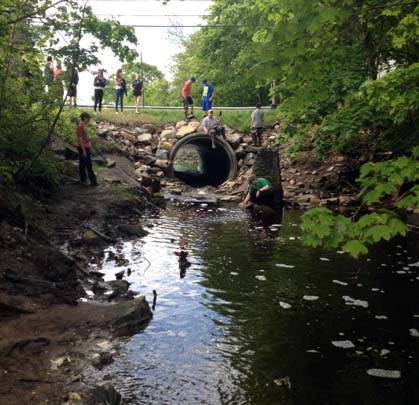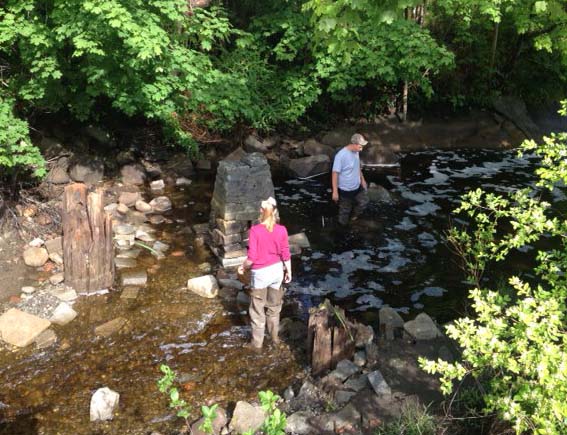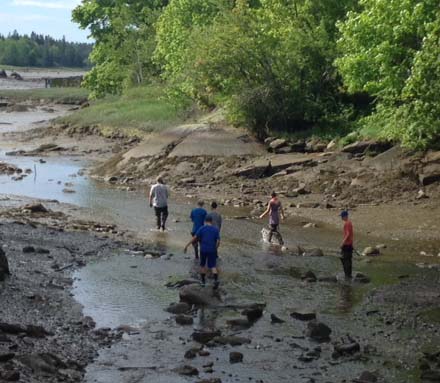 The St. George Middle School in Tenant’s Harbor is beautifully positioned next to Ripley Creek, a tidal stream that opens into a freshwater marsh.
The St. George Middle School in Tenant’s Harbor is beautifully positioned next to Ripley Creek, a tidal stream that opens into a freshwater marsh.
This marsh teemed with spawning alewives until the 1980s when a new culvert constructed in Ripley Creek blocked their passage. In 2015, the town replaced this culvert with a fish-friendly culvert. (Of note: NRCM strongly advocated for better culverts in 2009, and a law was enacted to ensure that replacement culverts allow fish passage.)
The town took additional measures to bring back the alewives. Between 2009 and 2013, they stocked the marsh with alewives. However, the alewives have not rebounded. Supported by a mini-grant from NRCM for supplies, the staff and students at St. George Middle School set out to find out why the alewives haven’t returned.
This amazing eighth grade class studied and researched alewives, their habitat, and their cultural significance from every angle. They took a multi-disciplinary approach that encompassed math, science, and language arts. When visiting with them, they bubbled over with enthusiasm to discuss this project.
 This project allowed students to 1) immerse themselves—quite literally—in nature two or more times a week for research; 2) instill in the students a deep understanding of their watershed—how it relates to tides, to specific species, and human impact; 3) determine their own observations and theories as part of the scientific process, and 4) help the town determine their next steps for alewife restoration.
This project allowed students to 1) immerse themselves—quite literally—in nature two or more times a week for research; 2) instill in the students a deep understanding of their watershed—how it relates to tides, to specific species, and human impact; 3) determine their own observations and theories as part of the scientific process, and 4) help the town determine their next steps for alewife restoration.
Talk about empowering. They did all that and more.
Throughout the project, they brought in local residents who could talk about historical alewife runs and their place in the fishing community. They learned that pre-refrigeration, the marsh was used to harvest ice in the winter and then hay in other seasons. They met with a local artist who demonstrated how he uses art to advocate for environmental concerns.
The students’ research involved measuring the rate of water flow to determine if the flow was sufficient for the alewives to get through the culvert. I watched a video of how the students collectively determined the most effective way to measure stream flow. Ultimately they decided to measure one section of the stream using three transects.
What they found? The flow was not adequate for alewives to get to the marsh. The culvert is filled for a short window of two hours during high tide. The water levels of marsh are two feet lower than when the alewives were running. The creek today does not have pools for alewives to rest as the tide goes out, which it had in the past.
 What else did they find? ALEWIVES! They reported around 30 alewives resting in the culvert. Students and teachers alike were thrilled with this discovery. They netted and moved alewives from the culvert to the marsh.
What else did they find? ALEWIVES! They reported around 30 alewives resting in the culvert. Students and teachers alike were thrilled with this discovery. They netted and moved alewives from the culvert to the marsh.
This indicated that the focal point for restoring alewives really is the section of Ripley Creek from the culvert to the marsh and the marsh itself.
At the end of their project, the students had several recommendations for alewife restoration, including raising the level of the water in the marsh, creating a series of resting pools, constructing a permanent fish ladder, restocking the marsh with alewives, studying the oxygen level in the marsh, and cleaning up litter in the outlet stream.
I was impressed. This was an extraordinary effort. And, it will serve as a springboard for alewife restoration to continue in their community.
These students will go far in life but wherever they go, they will forever have ties to a really cool fish in a really cool Maine ecosystem. And, it’s likely their efforts restoring alewives will serve as a reminder that humans need to be mindful of our impact on all species—everywhere.
Nicely done!
—by Stacie Haines, NRCM Membership Director









Leave a Reply